
Broadgate
Page updated 3rd November 2016
 This small street, linking the western end of
Cathedral Yard with the High Street was the main gate into Cathedral
Close when it was created in 1286, with the
permission of Edward I –it was also known as St
Michael's Gate–over the arched entrance, facing the Cathedral was placed in a niche, a statur of Archangel Michael overcoming Satan. Although it
was one of the three widest gates leading into the close, it was still
only 3 meters wide. The gate was documented in 1344 as Fishfoldyete, due to its proximity to the fish market in the High Street. In the 16th century, Hooker noted that it was
sometimes called Fissand, meaning a narrow fissure.
This small street, linking the western end of
Cathedral Yard with the High Street was the main gate into Cathedral
Close when it was created in 1286, with the
permission of Edward I –it was also known as St
Michael's Gate–over the arched entrance, facing the Cathedral was placed in a niche, a statur of Archangel Michael overcoming Satan. Although it
was one of the three widest gates leading into the close, it was still
only 3 meters wide. The gate was documented in 1344 as Fishfoldyete, due to its proximity to the fish market in the High Street. In the 16th century, Hooker noted that it was
sometimes called Fissand, meaning a narrow fissure.
Of all the gates of the Close, Broadgate was the most impressive, probably because it gave direct access from the High Street, and a link with the Guildhall. The gate in the illustration probably dates to the 15th Century. By tradition, a new Bishop of Exeter is greeted by the Mayor at the Eastgate and escorted to Broadgate, the greatest of the gates, to be greeted by the Dean of the cathedral. One such visit, when Bishop William Carey came to the city, in January 1821, the occasion was described in the Flying Post thus:
"At Broad-gate, the principal entrance to the Close, or Precinct of the Church, his Lordship was met by the Precentor, Sub-Dean, Chancellor, Canons, Prebends, Lay-Officers of the Ecclesiastical Court, and Choir, and the Mayor introduced him to the Precentor. With this addition to the procession they advanced down the Yard to the Cathedral."
When Exeter had its own assize, the Judge, Mayor and other dignitories would also proceed, from the Guildhall, through Broadgate for a service in the Cathedral.
Like many gates in the city, it had accommodation built over the archway. Broadgate was used for housing members of the cathedral staff including the main gatekeeper for the close, whose duties included removing undesirables, including females, from the close at night. In 1815, it was also the residence of the Cathedral Scavenger, who cleared animal dung and rubbish, and the Lamplighter.
Jenkins in his History of the City of Exeter wrote of the statue that resided in a niche over the arch.
"The principal gate is now called the Broad-gate, anciently St. Michael's, from its having the statue of that Archangel, overcoming Satan, placed in the interior front; this embellishment is now much mutilated. In the vaulting of this gate is displayed elegant tracery."
In 1778 several images of Roman gods were said to have been found under a house next to Broadgate, indicating that there had been a Roman household shrine at that spot. The houses were being demolished for the new City Bank, that was constructed in 1793.
Edward Upham occupied a shop at Broadgate in 1801 when he offered Cary's New English Atlas for sale.
Although one of the widest of the seven gates, it was still equipped with strong, double doors. The gate started to become a hindrance to stage coaches, entering the close, heading to the Hotel (Royal Clarence Hotel). The Royal Clarence offered its clientele the Royal Bath and the London Mail services on a daily basis. The manager of the hotel petitioned the Cathedral authorities in the early 19th century to have the gate removed after a coach hit the side of the gate, resulting in the horses panicking and breaking away to gallop along the road to the Royal Clarence leaving the passengers stranded. By 1823 plans were afoot to deal with the Broadgate, and a letter in the Flying Post from "One of the Old School" expressed the view that the old gate should not be vandalized, but should be preserved.
The removal of Broadgate
In the early 19th century, just before it was demolished it was described as a filthy quagmire. While consideration was made for the removal of Broadgate, the Flying Post published man letters, for and against the destruction. This letter against modernisation had a nice turn of phrase:
"...can they (dignitaries of the church) silently look on, when Vandalic violence is threatened to Broadgate, the beautiful accompaniment and outwork of this very Cathedral?.... Exonians should be as proud of this ornament of their city, as Soldiers are of trophies and banners wrested from the enemy." It was signed One of the Old School.
Another letter used strong irony, even a little satire to argue the case for keeping the gate.
"Let me congratulate you, my polished fellow-citizens, on your zeal for improvement. .... To be sure they were well meaning people (forefathers): but ignorance made them prefer old Broadgate to a spruce milliner's shop, and the Painted East Window of St. Peter's Church, to the bow-window of Mr. C.'s tap room." Signed by Modernus. It just seems some modern controversies are really as old as the hills!
An opinion in favour of the demolition is given in full, as it mentions improvements to what would become the Tinleys (Miss Smale's) building.
WHY HALT BETWEEN TWO OPINIONS?
Mr. Editor
In contemplating the result of the improvements now making in the streets of the city of Exeter, none affords more gratification than the intended enlargement of the opening from the High-street into the Cathedral-yard, at Broadgate, and it is to be hoped that the line of buildings on the southern side will be made from the corner of Mr. Cox's shop, to meet the City Bank close within the gate house, making a parallel line on the opposite side against Messrs. Clark and Smale's premises, leaving the space not less than 23 or 24 feet wide between the houses, whereof 4 feet on each side to be footways, and the residue, 15 or 16 feet, for horse and carriage way, by which plan the front shop of Mr. Clark's will not be affected, and probably some equivalent may remain of Miss Smale's premises that might be given up for what would require to be cut away from Clark's back rooms. Another grand object would be hereby obtained–a view of St. Peter's Cathedral from the High-street, which would be less conspicuous, if the, opening is contracted at Cox's corner, and if the whole of Smale's front towards the yard is not thrown open to the street. If the front of Mr. Cox's house was cut back in a line with Mr. Lee's, it would be a further improvement. A Public Accommodator.
The Committee of the Improvement Commission sanctioned the demolition with a 25 to 9 majority. Work to remove the gate commenced on 28th December 1824 and the highway was reopened on the 28th February 1825. During the two months of demolition, the Defiance and other coaches that served the Hotel used the narrow Martins Lane. The roadway of Broadgate was eventually widened in 1833.
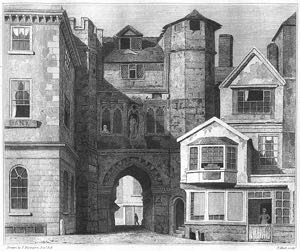 The Broadgate was probably 15th Century.
The Broadgate was probably 15th Century.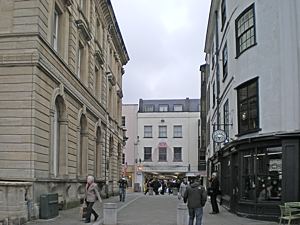 Broadgate with Jack Wills (City Bank) left and Pizza Express (Tinleys) right.
Broadgate with Jack Wills (City Bank) left and Pizza Express (Tinleys) right.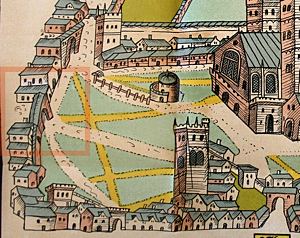 Broadgate is within the red outline tint, in this detail from Hooker's map of the mid 16th Century.
Broadgate is within the red outline tint, in this detail from Hooker's map of the mid 16th Century.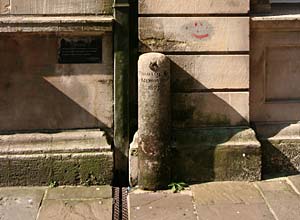 The post that marks Broadgate, is placed on the outer boundary of the old Broadgate.
The post that marks Broadgate, is placed on the outer boundary of the old Broadgate.
Rebuilding Broadgate
The print of the old Broadgate (tinted green) was made after the City Bank was constructed on the western side of Broadgate. The timber fronted buildings (tinted red) on the right, were set back from Cathedral Yard. In the front, in line with the present buildings were low, largely single story shops (in blue in the diagram) lining the close. So there was a front row of single story buildings backed by medieval, timber fronted houses (tinted red), of which, the corner building (blue) was occupied by Miss Smale.
Miss Smale's building was later extended to become the building we know today as Pizza Express, or the former Tinleys. The corner of the City Bank (untinted) can easily be mistaken for the City Bank building, that now houses Jack Wills (clothing). However, the building in the illustration was smaller (see map right), and in 1876/7, it was demolished, along with the corner City Bank, and rebuilt, back towards the High Street, and southwards to St Petrocks Church.
The City Bank again extended their bank in 1905 to the High Street. The join between the two was the outer boundary of the old Broadgate.
Nowadays, we always think of Broadgate as the short street between Cathedral Close and the High Street. The old Tinley's teashop, now Pizza Express, occupies one corner of the old gate and has part of the original wall erected in 1286, running through the rear of the building. Posts, marking the position of the gate, were installed soon after its demolition so that the Cathedral authorities could continue to claim jurisdiction over the Close. When Prince Charles visited in 1979, a ribbon was tied between the posts to symbolically represent a chain, which was once used to close Cathedral Close off with a chain, after the gate was removed.
During 2005, Broadgate has been pedestrianised, and the entry of cars into the Close is restricted to South Street only.
Sources: Flying Post, Alexander Jenkins and other pages on this site.
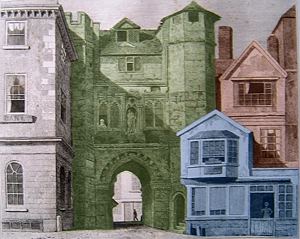 Drawn in 1822, this engraving by Nash, of Broadgate
from inside Cathedral Yard.
Drawn in 1822, this engraving by Nash, of Broadgate
from inside Cathedral Yard.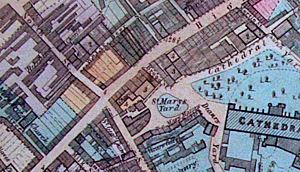 This map, dates from 1836. The building marked 3, was the Devon and Cornwall Bank. The narrow building marked 2 (difficult to read,) between Broadgate and the Devon and Cornwall Bank, was the City Bank. The two buildings were amalgamated in 1876/7.
This map, dates from 1836. The building marked 3, was the Devon and Cornwall Bank. The narrow building marked 2 (difficult to read,) between Broadgate and the Devon and Cornwall Bank, was the City Bank. The two buildings were amalgamated in 1876/7.
│ Top of Page │